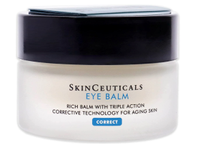How to get rid of dark circles under your eyes: Expert tips and professional treatments
The science and solution behind improving their appearance


If you've looked in the mirror recently and wondered how to get rid of dark circles under your eyes, you're not the only one.
Dark circles under our eyes causing you to worry? When it comes to getting rid of the heavy bags under your eyes, it's not just a quick one-fix for all solution. Sure you can apply one of the best eye creams for dark circles, but there's other lifestyle changes you'll want to avoid. After all, we all know that a lack of sleep leave you looking tired and can give you wrinkles, especially around the eye area.
Banishing those dark circles is a step-by-step process: figuring out why they're there in the first place, changing up your lifestyle and detoxing your system to work in more vitamins and minerals, and then treating the physical problem.
What causes dark circles under eyes?
While there are different causes of dark circles, the most common one is simply a lack of sleep. It makes our skin appear duller and paler, explains dermatologist Dr. Mary Sommerlad, "meaning dark tissues and blood vessels beneath your skin show more easily."
It could also be hereditary and the result of genetics, as dermatologist Dr. Shaaira Nasir says. "Combined with the fact that as we age, we naturally produce less collagen and elastin (which are responsible for the plumpness and elasticity of the skin), it means that the skin around the eyes can start to look tired, regardless of how much sleep you are getting."

Another reason for dark circles and bags under the eyes is hyperpigmentation, which can be caused by a combination of all three - lack of sleep, genetics, and age - along with other environmental factors, like sun damage and smoking.
Aesthetic practitioner Genevieve Knodell, who specialises in laser and light skincare, told us, "Dark circles can be caused by hyperpigmentation from sun damage and show up as epidermal pigment around the eye area. It occurs when an excess of melanin is produced by melanocytes, the pigment cells, which are moved up to the skin’s surface. It can also be caused by inflammation, hormonal stress, or other skin injuries. Darker skin tones are more prone to hyperpigmentation, especially with excess sun exposure."
In our ever-growing digital (and working from home) world, where we're staring at laptop screens for hours on end, dark eye circles are also becoming more common. The more time we spend in front of a screen, the more damage we're doing to our eyes - as eye specialists attest. This means that the blood vessels under the eyes are getting bigger too and creating dark circles.
Then there are the dietary factors that contribute to dark circles by limiting the blood circulation under the skin.
Dietary factors
The main dietary factor leading to dark eye circles is iron deficiency, the most common type of anaemia, as it's a sign that not enough oxygen is reaching the body's tissues.
When this happens, dark circles can form. Genevieve says, "Dark under-eye circles can also be due to the shadowing of deoxygenated blood in the delicate eye area. This area is much thinner and more transparent, and the shadowing can therefore be more apparent." Dark under-eye circles are common during pregnancy or menstruation for the same reason, especially if the person is already struggling with a lack of iron.

Food intolerances and allergies can also have an impact on creating dark circles, as they cause physical reactions like inflammation under the eyes.
So while there seems to be a long list of causes, with everything from genetics to sun damage having the potential to cause dark eye circles, they're easy to manage most of the time through lifestyle changes and home treatments.
How to avoid dark circles from a lifestyle perspective
1. Get more sleep
As one of the primary factors causing dark circles and bags under the eyes is a lack of sleep, it makes sense to try and get more hours in. Even just one hour of poor sleep has a negative effect on our skin, leading to dark circles and swollen eyes most commonly.
Seven to nine hours a night is recommended but it's not unusal to struggle to drift off, especially in these trying times. There are loads of easy ways to help you fall asleep though that involve basic lifestyle changes such as fixing your sleeping schedule and changing up your sleep environment.
However, sleep problems can be caused by all sorts of issues and more severe sleeping disturbances such as insomnia and having nightmares could be a sign of something more serious. Struggling to sleep in the long-term can also lead to other major health issues, so it's important to consult a doctor if you're really struggling to get to sleep at night.
2. Eat a balanced vitamin rich diet
An anti-inflammatory diet, packed with fresh fruit and vegetables, whole grains, protein and healthy fats, should help to get rid of dark circles. They have proven benefits in boosting oxygen circulation around the whole body - including the skin - and lessening the appearance of dark circles.
Tomatoes are one of the best foods to eat as they are packed with lycopene, a powerful antioxidant. Green tea also has major health benefits. Berries, oranges, bell peppers and leafy green vegetables are also fantastic foods for reducing under eye circles as they're high in vitamin C and A. Along with collagen boosting ingredients such as peptides and stem cells, Genevieve says that these "help volumise and build the dermis to thicken the skin to help improve the under-eye appearance."
But coffee lovers beware! Drinking three to four cups of coffee per day could be contributing to dark circles under the eyes. When we overload on caffeine, adrenaline is released and the body goes into 'fight' or 'flight' mode because it believes we're in danger. During this time, blood vessels in the skin constrict (to stop the blood flow from any cuts on the body). While this is a saviour in some circumstances, it's only going to make those dark circles darker.
In the same way, a glass of wine is absolutely fine but "two or more drinks would seem to turn on systems that stress the circulation. If these actions are repeated frequently because of high alcohol consumption these effects may expose individuals to a higher risk of heart attacks, stroke or chronic high blood pressure,” explains Dr. John Floras, director of cardiology research at the Peter Munk Cardiac Centre.
To mitigate the effects, try one of the best non-alcoholic wines instead.

3. Stay hydrated
We're always being told to drink more water for one reason or another, but hydration drastically improves the appearance of dark circles, our experts say.
As well as drinking plenty of water a day (3 litres minimum) though, you can utilise the benefits externally as well. Multiple studies have proven that topical application of cold water (in ice, for example) does wonders for our nervous and cardiovascular systems.
Specific to the skin though, this works as ice produces a dilation effect in the blood vessels, which increases blood flow to the tissues underneath the skin. When applied directly under the eyes, it helps to reduce the dark shadows by flooding the area with blood again.
4. Adopt a good skincare routine
A good skincare routine is essential to get rid of dark circles and bags under the eyes, while also warding off acne, reducing preventable signs of ageing, and generally keeping skin happy and healthy.
Along with the essentials, such as a moisturiser that includes SPF or sunscreen for your face, there are additions you can make to your skincare routine to beat dark circles.
Dermatologist Dr. Nasir recommends SkinCeuticals Eye Balm for those with more mature skin.
- SkinCeuticals Eye Balm - £69 at Amazon
Dr. Nasir adds "Another excellent anti-aging option is Medik8 C-Tetra® Eye, which is a gentle yet powerful serum designed to smooth fine lines and wrinkles specifically around the eye area to make the skin appear fresh and rejuvenated."
- Medik8 C-Tetra® Eye - £20 at Amazon
Retinol is skincare essential that's taken the beauty world by storm in the past year and for good reason too, Dr Nasir explains. "Retinol is generally regarded to be the most effective anti-aging ingredient."
She recommends the Medik8 Intelligent Retinol 3-10TR as it's a fast-absorbing anti-ageing serum that tackles fine lines, wrinkles and dullness whilst being gentle on the skin.
"With 0.3% retinol, it is the ideal product if you haven’t used this ingredient on your skin before and want to test it out."
- Medik8 Intelligent Retinol 3-10TR - £40 at Look Fantastic
"For a product that plumps and smooths," Dr. Nasir says, "Try The Organic Pharmacy Hyaluronic Acid Serum, which is clinically proven to increase the skin's moisture levels, leaving it soft and smooth, and with visibly reduced lines and wrinkles.
It features 0.2% hyaluronic acid to boost the skin's natural protective barrier and lock in moisture for longer."
- The Organic Pharmacy Hyaluronic Acid Serum - £30 at Look Fantastic
While Dr Mary Sommerlad recommends products with brightening ingredients, such as kojic acid, Vitamin A and Vitamin C.
"My favourite product at the moment is Skinceuticals A.G.E Eye Complex, which is an eye cream for dark circles. It has optical diffusers which disguise under eye darkness and rejuvenate dull, tired-looking skin.”
- Skinceuticals A.G.E Eye Complex - £85 at Look Fantastic
Everyone's skin is different though and will react to products in different ways, depending on sensitivity. If you're concerned about which products are likely to aggravate your skin, it's best to visit a dermatologist before taking up a new skin therapy treatment.
Other highly rated retinol products include:
- La Roche-Posay's Retinol 0.3% + Vitamin B3 Serum- £38 at Look Fantastic
- Dermalogica Retinol Oil - £69 at Look Fantastic
- For those looking for a more budget-friendly option, there's NIP+FAB Retinol Fix Eye Treatment - £19.95 at Look Fantastic
5. Lymphatic drainage massage
Along with wearing sunglasses to decrease sun exposure to the area, "a light lymphatic drainage massage around the eye area when applying your eye cream will also be beneficial", Genevieve explains.
How to hide dark circles under eyes
The easiest way to cover dark circles is with makeup, beauty expert Samantha Keighley says. "Depending on the colour that is showing under your eyes, you can use either a yellow or peachy toned concealer to cover them.
"One of my favourite under-eye concealers is the Becca Under Eye Brightening Corrector. I apply a little bit under my eyes after doing my skincare each morning and it makes me look more awake, even if I’m not wearing any other makeup."
- Becca Under Eye Brightening Corrector - £33 at Amazon
If you want the best of the best then FRAÎCHEUR PARIS is your best bet. Used by those within the beauty industry, simply pop it in your freezer the night before and remove it to use in the morning.
- FRAÎCHEUR PARIS Ice Globes (Blue) - £59.99 at Cult Beauty
Samantha adds, "Using ice globes or cyro balls under the eyes after cleansing each morning should also help, she says. "These can be stored in the freezer ready for you to grab them out and run them under and over the eyes to help de-puff the skin and oxygenate it. This will all help to reduce the appearance of dark circles."
Samantha says that after using these, going forward with your skincare routine should hide dark circles effectively.
How to get rid of dark circles: Professional treatments
1. Cyspera
An option, which lies in the middle of natural and professional, is at-home treatment Cyspera. "Cyspera is a biological depigmenting treatment for hyperpigmentation concerns," says aesthetic practitioner Genevieve.
She explains: "It is a good at home treatment that we recommend to most patient with pigment concerns. The active ingredient is cysteamine. Naturally present in human skin cells, cysteamine regulates melanin synthesis in the skin. It has been formulated to work as an effective topical treatment, Cyspera."
2. Chemical Peel
A chemical peel is one of the ways to restore skin under the eyes, Genevieve says. It contains particular acids that can help with sun damage and strengthen the skin around the eyes.
"Opt for specific peels designed to treat the delicate eye area that will deliver brighter, more even skin tone, and reduce the appearance of dark circles, fine lines and instantly refresh the concerned area." She says, "The less layers of pigment in the skin the lighter it will become. So, by stimulating cell turnover and peeling away the dead damaged layers to reveal new skin, it will help even skin tone and lighten pigment to a degree."
Although the specific peel and acids used will depend on skin sensitivity, the Fitzpatrick skin type and on what needs to be treated.
One option is the peel from Neostrata at Stratum Dermatology Clinics. This offers a 3% retinol peel, which according to Genevieve, is "fantastic in addressing issues such as sun damage, sunspots, hyperpigmentation and PIH (post inflammatory hyperpigmentation). A course of three to six treatments combined with good home care maintenance would be recommended for the best results."
3. Laser treatment
Laser treatment is another option to reduce hyperpigmentation, Genevieve says. "Treatments like skin pen utilising microneedling technology, combined with skin boosters, could also help to improve under-eye appearance."
While a chemical peel readily treats hyperpigmentation, a laser treatment is a good choice for making changes in the texture of the skin. It particularly helps with scarring and deeper skin damage.
4. Microneedling
"If you aren’t keen on injectable, then microneedling could be more your thing." Dr Nasir suggests, "It involves using small needles to cause tiny punctures to the skin which stimulates the healing process. As the skin repairs, the production of collagen and elastin is triggered and your skin almost immediately looks and feels invigorated and plump, smoothing out the appearance of fine lines and wrinkles. Treatment starts at £150."
It's also a common way that dermatologists handle skin traumas including acne scars, burn scars, alopecia and stretch marks. It's not as painful as it sounds though. Our experts assure they use numbing cream to help reduce any discomfort.
5. Tear trough filler
"Dark circles under the eyes can sometimes be due to loss of volume under the eyes and this can be corrected by under-eye filler also known as tear-trough filler." Dr Nasir says, "This will plump up the area under the eye by reducing the shadow effect caused by hollowness, and will reduce the appearance of fine lines under the eyes making the eye area look more hydrated. The treatment lasts up to 18 months and cost around £390."
With any of these treatments though, it's essential that a trained professional conducts them. Always consult a skin specialist such as a dermatologist before taking up any of these treatments.
Video of the Week
Goodto Newsletter
Parenting advice, hot topics, best buys and family finance tips delivered straight to your inbox.

Grace Walsh is a Features Writer for Goodto.com, covering breaking news health stories during the Covid-19 pandemic as well as lifestyle and entertainment topics. She has worked in media since graduating from the University of Warwick in 2019 with a degree in Classical Civilisation and a year spent abroad in Italy. It was here that Grace caught the bug for journalism, after becoming involved in the university’s student newspaper and radio station.
-
 Family therapist reveals the 5 key phrases not to say to your kids this Christmas – and #3 is a pitfall every parent can relate to
Family therapist reveals the 5 key phrases not to say to your kids this Christmas – and #3 is a pitfall every parent can relate toFor a holly jolly Christmas, watch your words, says parenting expert
By Daniella Gray Published
-
 The days of grandparent childcare are numbered as millennials feel 'frustrated' with parents too busy to look after grandkids (and it's bad news for nursery costs)
The days of grandparent childcare are numbered as millennials feel 'frustrated' with parents too busy to look after grandkids (and it's bad news for nursery costs)Busy grandparents are adding to millennials' childcare concerns - and apparently it's a 'common struggle'
By Ellie Hutchings Published






